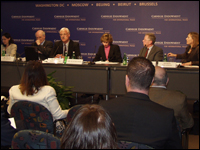Registration
You will receive an email confirming your registration.
IMGXYZ903IMGZYXOn May 22, Carnegie’s Nonproliferation Program and the Center for Arms Control and Nonproliferation hosted a discussion on the Global Nuclear Energy Partnership (GNEP). Launched in 2006 by the Bush Administration, GNEP has sought to develop a consensus for a nuclear fuel cycle that enhances energy security while promoting nonproliferation. Yet, many of its critics worry that GNEP’s solution—a closed fuel cycle that would reopen the question of reprocessing of spent fuel in the United States—may be worse than the problem. While the international component of GNEP has garnered considerable support with 20 partners worldwide, the domestic component has come under fire in Congress, which denied over half of the Administration’s funding request for GNEP in FY2008. Recent reports—by the National Academy of Sciences and by the Government Accountability Office—have urged the Department of Energy to take a slower approach.
Buzz Savage, GNEP Deputy Director of Technology at the U.S. Department of Energy, kicked off the discussion by describing the advantages of the GNEP approach—the recovery and reuse of fuel resources, reducing the volume of high-level waste and its toxicity, better waste packaging for safety and environmental protection, and creation of many new jobs. Savage acknowledged the proliferation risks in reprocessing yet stressed that any technology deployed in the United States would not separate plutonium.
Dr. Alan Hanson, Executive Vice President of Technologies and Used Fuel Management at AREVA, suggested that an analysis of costs should focus not on reprocessing plants and plutonium fuel fabrication, but on the opportunity costs of not recovering the energy in the fuel. He noted that 96% of a used fuel assembly is recyclable and that the energy content of 1 gram of plutonium is equivalent to 1-2 metric tons of oil. Hanson cited a recent AREVA study that showed the costs of recycling could be attractive as the price of uranium rises. Nonetheless, he suggested that commercial reprocessing, or recycling, is between 10 and 25 years off in the future for the United States.
Dr. Allison Macfarlane, Associate Professor at George Mason University and member of the 2007 U.S. National Academy of Sciences Panel that reviewed GNEP, presented the findings of that panel’s report. She stressed the conclusion not to rush into commercial-scale reprocessing, citing the lack of urgency regarding waste, security, or resources. In her dissenting view, Macfarlane argued that GNEP will create problematic intermediate- and low-level wastes when cesium and strontium are removed, and that GNEP does not obviate the need for a repository. Macfarlane noted that fast-neutron reactors are expensive to build and present few barriers for theft of plutonium.
Dr. Frank von Hippel, Co-Chair of the International Panel on Fissile Materials and Professor at Princeton University, argued that GNEP was motivated by U.S. nuclear utilities desiring to recover the extra costs of nuclear waste storage resulting from delays in the opening of Yucca Mountain. Von Hippel argued against overturning the three-decades-long policy of the United States not encouraging the use of plutonium in the civilian sector on several counts: that plutonium in spent fuel is self-protecting and more secure against terrorist attack, that other countries have abandoned reprocessing as uneconomic, and that the discriminatory approach pursued internationally would ultimately fail.
During the question and answer session, the panelists debated the cost-effectiveness of recycling, whether or not other GNEP participants would buy into the new “recycling” technology that did not separate plutonium (it is a voluntary decision, and UREX plus is not a near-term solution), and why moving to fast reactors is necessary to reduce waste volume.
